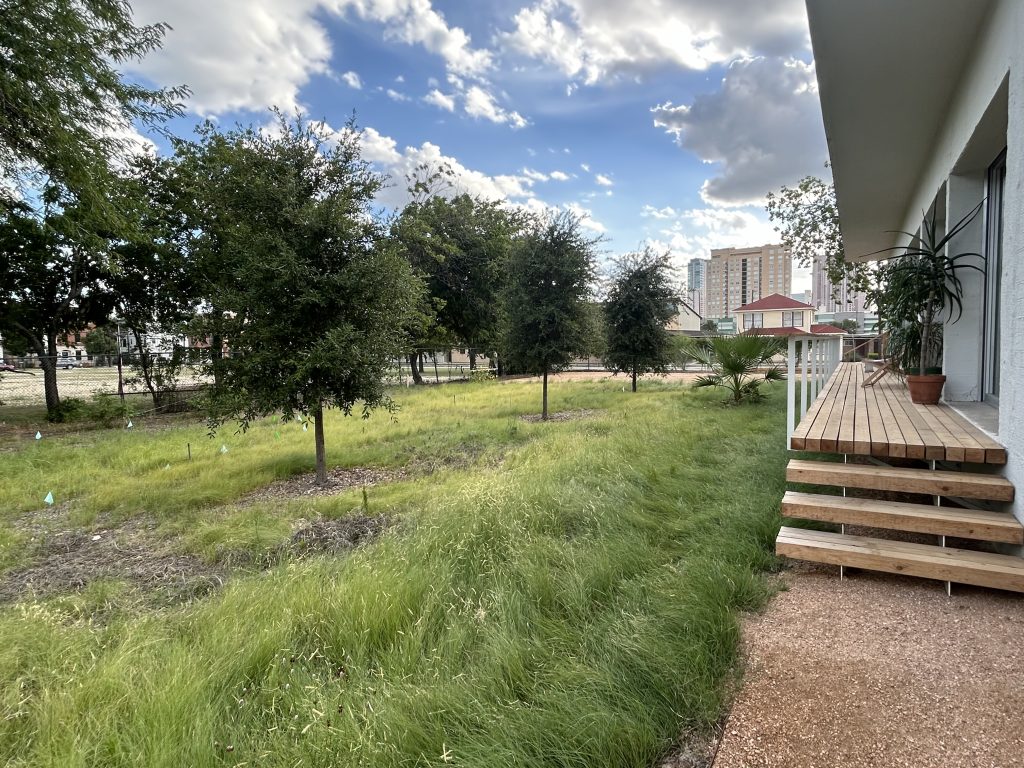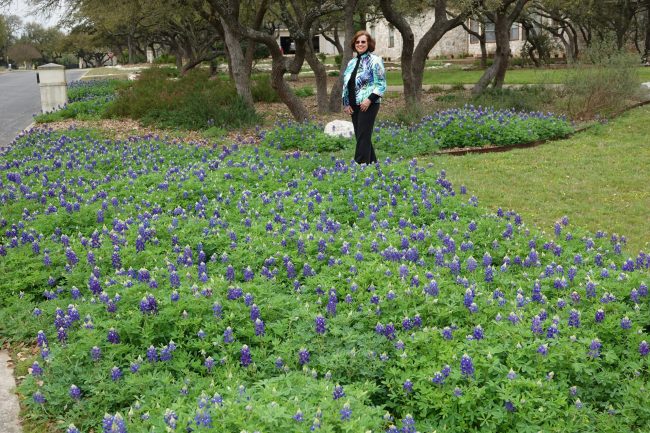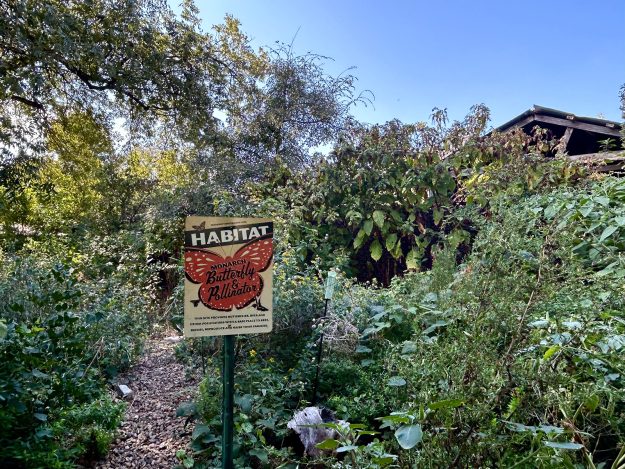A new generation of homeowners and gardeners is challenging the tradition of lawn-and-order in the front yard and embracing a more progressive approach: lawnlessness.
Native plants, pollinator habitat, vegetable, wildlife and rain gardens are replacing the classic welcome mat of pristine green turf. Motivations for the changing mindset range from pragmatic to aspirational. High water bills and maintenance costs can drive some homeowners into lawnless territory.
Matti Bills of San Antonio has always had a garden. “I would never plant grass,” said the 32-year-old restaurant entrepreneur. “It’s a complete waste of resources.” While Bills and her partner Nicolas Rivard have some legacy grass from their home’s previous owner, a robust herb and vegetable garden, a barbecue pit, and bird friendly plants occupy most of the front yard.
Another millennial couple, Cotton Estes and Mike Long, recently converted a former bus depot into a native prairie. It would have been more efficient and way less expensive to plant the usual nonnative St. Augustine or Bermuda grass, but the couple opted for long-haired native grasses. “We were looking for something that takes on a life of its own, bold and resilient and adding diversity,” said Estes, an architect.
Ann Lawrence embraced a lawnless yard out of practicality. The 80-year-old San Antonian, disabled at the time of her conversion, was no longer able to push a lawnmower, nor could she afford a mow-and-blow crew on her Social Security income. She presented a plan to remove grass from her landscape to the Lookout Creek Canyon Homeowners Association on. At first it was rejected for featuring “too much mulch.” After amending the plan, it was approved.

Native prairie installed by Cotton Estes and Mike Long. Would have been way easier and cheaper to do traditional lawn. –Photo by Monika Maeckle
Those in the native plant business like Donald and Melanie Gerber, owners of San Antonio’s Pollinatives native plant nursery, welcome the change. Donald expressed optimism about their business and what he sees as an embrace of native plants and a rejection of lawns. He said the nursery industry trade magazines present the change as a generational shift. “Broadly, boomers are into their lawns and millennials and younger are not,” he said.
Lawn-and-order landscaping has roots in European aristocracy, inspired by Versailles and popularized by George Washington’s Mount Vernon and Thomas Jefferson’s Monticello. Outdated city codes and rules created by Homeowners Associations (HOAs), continue to encourage lawns. The rationale? A lush, well maintained lawn provides a familiar green welcome mat to properties large or small, and signals wealth, status, control, and a sense of belonging.

Maintaining a lush green lawn during times of drought can be a challenge. –Photo courtesy SAWS
But maintaining these lawns is expensive–fiscally and environmentally–especially in times of drought and strained water resources. One industry report had homeowners in the U.S. spending more than $100 billion on lawn care each year, and that’s just the financial cost. Lawns are considered environmental dead zones, contributing nothing to the ecosystem beyond a desired look by some. And yet the majority of homeowners still spend massive amounts of time, energy and money watering, weeding, mowing and dumping chemicals in our increasingly hot climate, as record drought and water shortages rage.
Unfortunately, HOAs continue to hound their members to practice lawn-and-order over lawnlessness.
Don Kirchoff, president of the San Antonio chapter of the Native Prairies Association of Texas, was taken to task by the Forest at Stone Oak HOA in 2020 for hosting “weeds” in his front yard. It cited him and his wife, Joyce Peterson, with a breach of the HOA’s declaration of covenants, conditions, and restrictions. The HOA accused the couple of violating an HOA regulation that stated “grass, weeds, and vegetation on each Lot shall be kept mowed at regular intervals.” In short, they needed to mow their front yard. The letter arrived during one of the hottest, driest periods in decades which followed years of San Antonio experiencing “Exceptional Drought,” so declared by the National Drought Mitigation Center.
Kirchoff’s yard indeed was home to some half-foot-tall greenery, but it was neither grass or weeds. The vegetation, a patch of bluebonnets, was the state flower of Texas.

The “weeds” in the Kirchoffs’ front yard. –Photo courtesy Don Kirchoff
Kirchoff said he “educated them a bit” and his bluebonnets were granted a reprieve. The issue then resurfaced in 2024, when Kirchoff once again received multiple notices of violations from what he calls “the plant police.” Again, they insisted he “cut the weeds.” After much back and forth and the assistance of a likeminded neighbor who joined the HOA’s board, the plant police backed off.
While native plants seem to be moving into the mainstream–San Antonio has seen the launch of two native plant nursery in the last two years–many would argue that the redirect should have come to Texas much sooner. In 2013, Senate Bill 198 passed unanimously and assures that any resident of the Lone Star State living under the governance of an HOA can install drought-resistant landscaping or water-conserving turf. The HOAs can still require homeowners to submit plans for approval, however. And yet, despite the passage of this “xeriscaping law” in Texas more than a decade ago, HOA-vs.-homeowner landscaping conflicts continue.
Overcoming resistance to HOAs and other regulations can be challenging, but education and patience are key, according to Karen Guz, director of conservation at SAWS, San Antonio’s municipal water utility. Guz said that while she and her team are often approached for assistance in conflicts between homeowners who are SAWS customers and their HOAs, a wider acceptance of non lawn landscapes appears to be taking hold.
“I have no strong data but it does seem to be a generational shift,” she said. She added that younger homeowners seem to be more intrigued by alternative landscape design and want yards that are sustainable and low maintenance.
HOAs often have highly specific objections. “They’re afraid it will turn into a rockscape,” she said. Or perhaps they want a thoughtful design and to have the house traditionally framed and not blocked by a barrier of plants. “There’s kind of an aesthetic that they want to maintain, and a truly wild looking landscape that resembles nature may not be what they’re looking for.”
Guz says convincing HOAs and others to accept non lawn yards requires reassurance that people will execute reasonable landscape design and good maintenance. Installing a sign that announces the yard’s intentionality helps communicate its purpose and assists with acceptance. “The good news is that it can be done,” said Guz.
TOP PHOTO: A sign lets people know you intentionally are cultivating a wildscape or pollinator garden. Here, a downtown San Antonio backyard. –Photo by Monika Maeckle
Related Articles
- San Antonio architect converts downtown parking lot into a native “prairie cloud”
- Wherehousebarn pollinator garden beckons butterflies and tenants to downtown San Antonio
- In the butterfly garden: use solarization to convert ugly grass into a vibrant butterfly garden
- Adding pollinator habitat to resilience gardens can boost yields and relieve stress
- HOAs resist native plant landscaping despite conservation benefits
- How to plan a successful butterfly garden
- Mostly native butterfly garden outperforms lawn every time
- Downtown River walk plot converts to pollinator garden, creature haven
- A year in the life of an urban butterfly garden
Like what you’re reading? Don’t miss a single article from the Texas Butterfly Ranch. Sign up for email delivery at the bottom of this page, like us on Facebook, follow us on Twitter, @monikam or on Instagram. And check out my book on the monarch butterfly migration!



What about the areas that allow deer to free roam which destroy many native plants? I wonder if fences could be put up high enough to keep deer out of those yards trying to eliminate grasses and grow food for themselves as well as birds, bees and butterflies?